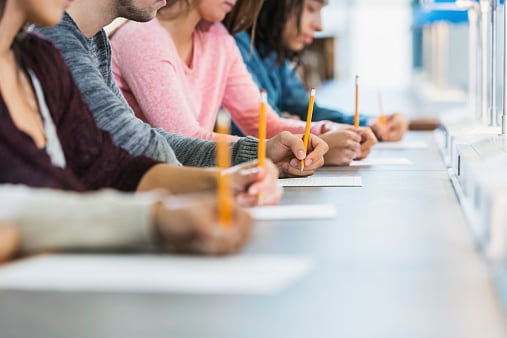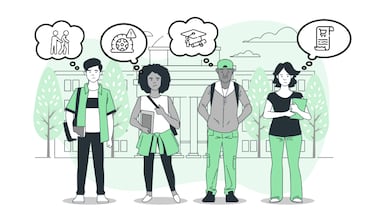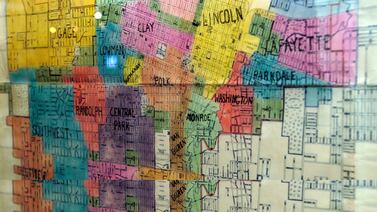Chicago’s latest scores on a test known as the “nation’s report card” showed steep declines in math while holding fairly steady in reading.
The results from the National Assessment of Educational Progress — or NAEP — test released today add to a growing body of evidence quantifying the academic damage from pandemic disruptions.
The declines return achievement levels to what they were about a decade ago — reversing years of progress for Chicago Public Schools. Across Illinois, scores exceeded the national average and mostly remained flat, but there was a marked decrease in eighth grade math.
U.S. Secretary of Education Miguel Cardona called the national scores “appalling and unacceptable.”
“These are definitely sobering test scores,” said Bogdana Chkoumbova, Chicago Public Schools’ chief education officer. She added, “It’s sad to see some of the progress that we had made in the past several years wiped off.”
In Chicago, the test also offered fresh evidence that the academic fallout has been greatest for Latino and Black students. White students generally saw scores dip more slightly, widening pre-pandemic disparities.
But there were also bright spots: Overall, the district, which had seen declines in reading scores leading up to the pandemic, saw dips in reading that are not considered statistically significant. Reading scores ticked up slightly for eighth grade Latino students. English language learners made significant gains and now outperform peers in other urban districts and nationally.
Chkoumbova said officials are also seeing signs this fall that some recovery strategies are paying off, including staffing tutors and academic interventionists, expanding after-school programs, and enlisting instructional coaches to help teachers.
Latest NAEP scores are first since 2019
The NAEP is considered one of the country’s most definitive measures of where students stand academically. Fourth- and eighth-graders across the country take the test administered by the federal government, which allows comparisons to be made across states and over time. Students in Chicago and elsewhere last took the test in 2019, on the eve of massive disruption from the COVID outbreak and a shift to remote learning. A representative sample sat for the latest test from January through March.
Scores for Illinois as a whole were flat between 2019 and 2022 for fourth graders in both reading and math — one of the few states across the country that held its ground in that grade. Eighth grade scores dipped, particularly in math, where the decrease was most pronounced nationally as well.
“We are proud that Illinois students scored above the national average in both reading and math for grades 4 and 8,” the Illinois State Board of Education said in a statement. “This is the nation’s gold standard report card, and this demonstrates that our investments in learning recovery serve as a national model because they are working. We have much work to do, but this is an important indication that our students are on the right track.”
Nationally, students in fourth and eighth grade saw unprecedented declines in math and significant dips in reading achievement between 2019 and 2022. The declines were broad-based — affecting students in virtually every state and region of the country. Other research has already shown that academic progress was derailed during that period. But the results from the closely watched NAEP exam provide the most detailed and authoritative accounting yet, with data coming from a representative set of students nationwide and allowing for comparisons across states and some cities.
Before the pandemic, Chicago’s average math scores had remained essentially unchanged since the mid-2010s, after a decade of steady improvement in both reading and math.
On the 2019 test, the city’s average reading scores had slipped, and the city lagged slightly behind other urban districts. The eighth grade drop mirrored a dip in eighth grade reading scores nationwide, which had remained largely flat for about a decade.
In both eighth grade reading and math, Chicago’s 2022 scores put it roughly in the middle of the pack among about two dozen large districts that administered the tests. Here, about a fifth of fourth graders scored “proficient” in math and reading, which represents a more than 10 percentage point drop in math. Another fifth of eighth graders scored “proficient” in reading and 16% did in math on the test, which sets a relatively high bar for proficiency.
Racial gaps in NAEP scores widen
The district has also grappled with significant racial and income disparities in how its students perform on the test.
Based on the latest scores, some of these disparities only widened during the pandemic. In both fourth and eighth grade math in particular, the disparities between scores for Black and white students widened to more than 40 points. The gaps between low-income students and their peers generally increased as well.
Students with disabilities also lost ground on the tests, though that decline was not as steep as it was for other student groups.
Chkoumbova said the district has used its “opportunity index,” which draws on student demographics and other data, to direct the most recovery resources to the schools with the highest needs, including those serving the most Black and low-income students. That’s an approach officials say they hope will help the district attack widening disparities.
Federal and Chicago education officials both said they found falling math scores and proficiency particularly troubling in the eighth grade — a gateway to more advanced math coursework in high school that prepares students for STEM careers. Chicago had one of the steepest declines in eighth grade math scores.
In part because of pre-COVID dips in reading scores, the district set out to redouble its early literacy efforts, with a focus on structured phonics instruction for young learners. Mary Beck, the district’s head of teaching and learning, credited these efforts with helping the district hold the ground in reading.
She said across the board, she expects the district to recoup lost ground on the NAEP much faster than it took to make those 2010 gains.
“Our ability to rebound and reach higher — we’re much better primed for that,” she said.
Impact of remote learning difficult to determine
It is challenging to tease out the academic impact of remote learning from the broader pandemic disruption, including the trauma students experienced as families grappled with illness, death, economic fallout, and a rise in gun violence. Still, new evidence is emerging that virtual learning contributed to declines in learning.
Chicago stuck with remote learning longer than some other urban districts, reopening for hybrid instruction in March of 2021 for elementary and middle school students, and in mid-April for high schoolers. On a call with reporters, Peggy Carr, commissioner of National Center for Education Statistics, which administers the test, said the scores paint a complicated picture of the role of virtual learning, and the agency would study the data more closely before drawing any conclusions.
A Chalkbeat analysis of the national data found mixed evidence. In fourth grade math, states where schools were fully open for longer tended to see smaller declines in scores. In eighth grade math and fourth grade reading, there was also a relationship, but it was very modest. In eighth grade reading, there was no correlation at all.
In comparing scores to 2019 and previous years, an important caveat is in order: Chicago’s enrollment has shrunk steadily over the past decade, and although its racial makeup has remained largely unchanged more recently, it now serves a smaller portion of low-income students.
Plummeting national results in reading and math from a slightly different, long-term NAEP trend test made headlines when they came out in September, showing that the pandemic and remote learning had erased two decades of student academic growth.
“As a country we face enormous challenges, and there are many areas of serious concern in this data,” said Carr, referring to the latest data.
Mila Koumpilova is Chalkbeat Chicago’s senior reporter covering Chicago Public Schools. Contact Mila at mkoumpilova@chalkbeat.org.








